Ageing and sexing details:
|
JAN - JUL: after-second-year
unknown |
Body plumage provides no useful information
about age or sex in spring, though condition of wing feathers or rectrices can sometimes be assessed on a perched bird. Sex can be determined only during the breeding
season by brood patch or cloacal protuberance.
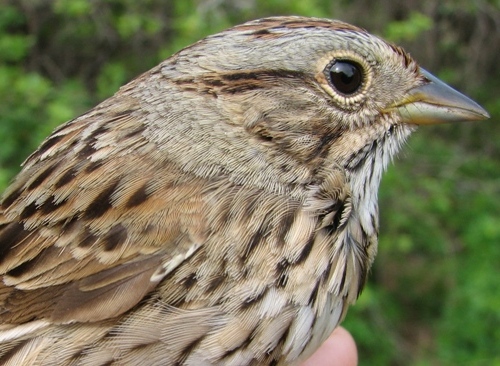
Photo by Barbara Frei,
McGill Bird Observatory (QC), May 2007
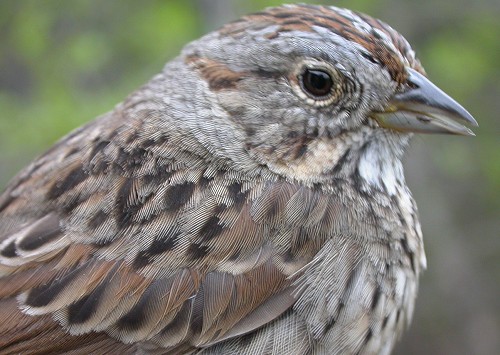
Photo by Marcel Gahbauer,
McGill Bird Observatory (QC), May 2006
ASY Lincoln's Sparrows have broad and truncate primary coverts, with pale brown edging that may or may not be readily visible. Note the relatively even wear of the primary coverts, primaries, secondaries, and greater coverts, but beware that in both age classes the tertials may appear contrastingly dark.
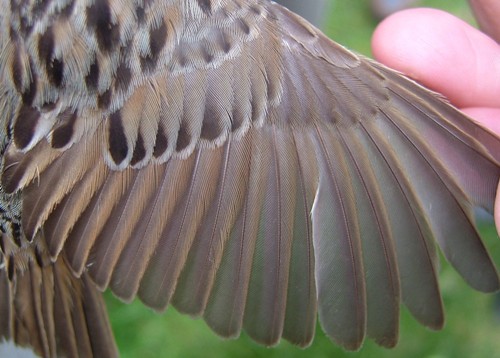
Photo by Peter Pyle, Big Sur Ornithology Lab (CA),
April 2006
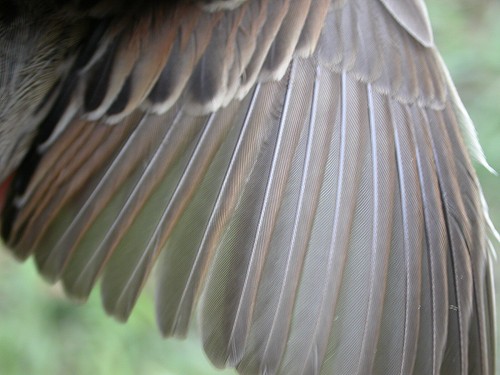
Photo by Marcel Gahbauer,
McGill Bird Observatory (QC), May 2006
Rectrices of ASY birds are fairly broad, and tend to be in better
condition than those of SY birds, though there can be considerable
variation, and the tail should generally not be used as a primary determinant of age.
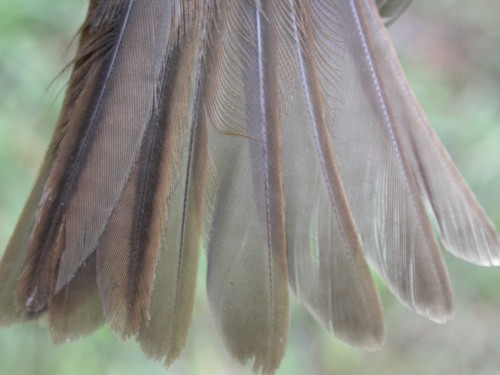
Photo by Marcel Gahbauer,
McGill Bird Observatory (QC), May 2006
RETURN TO AGE/SEX
OVERVIEW
|
JAN - JUL: second-year
unknown |
Body plumage provides no useful information
about age or sex in spring, although sometimes SY birds can be recognized when perched by their worn primary coverts or flight feathers. Sex can be determined only during the breeding
season by brood patch or cloacal protuberance.
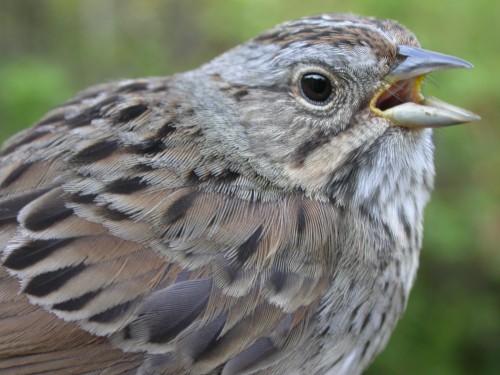
Photo by Marcel Gahbauer,
McGill Bird Observatory (QC), May 2006
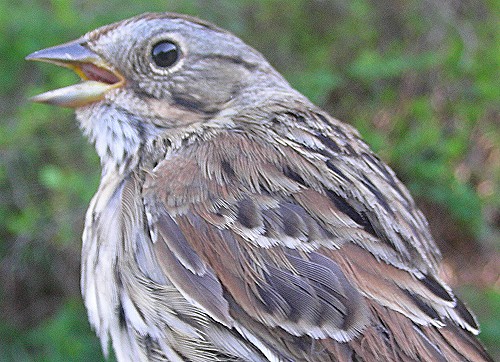
Note the alula, which appears paler and more worn than would be expected on ASY individuals.
Photo by Marie-Anne Hudson,
McGill Bird Observatory (QC), May 2007
Primary coverts tend to be relatively narrow, and more tapered at
the tip than on ASY birds, and also generally lacking in edging. The primaries and secondaries may also appear relatively pale and worn, as they are also juvenile feathers, resulting in a contrast between the fresher greater coverts and the older remainder of the wing.

Photo by Marie-Anne Hudson,
McGill Bird Observatory (QC), May 2007
SY Lincoln's Sparrows have relatively worn rectrices, usually also quite narrow and tapered.
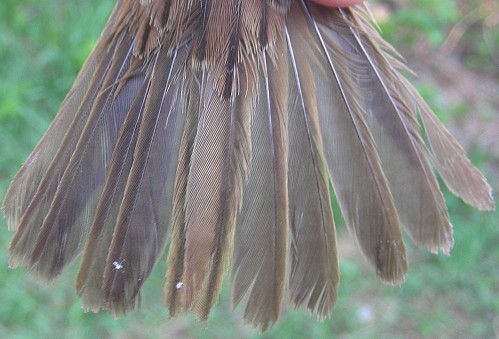
In this case the rectrices appear unusually broad, but are quite abraded.
Photo by Marie-Anne Hudson,
McGill Bird Observatory (QC), May 2007
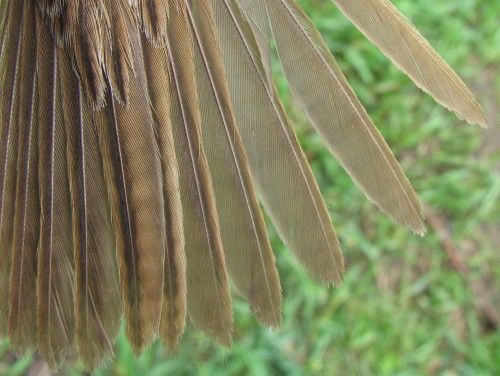
A more typical SY tail with respect to shape of the outer rectrices.
Photo by Barbara Frei, McGill Bird Observatory (QC), May
2006
RETURN TO AGE/SEX
OVERVIEW
|
JUL - DEC: after-hatch-year
unknown |
Most body plumage provides no useful information
about age or sex, but AHY Lincoln's Sparrows tend to have a more gray face than HY birds. Sex can be determined only through early fall by retention of brood patch or cloacal protuberance.
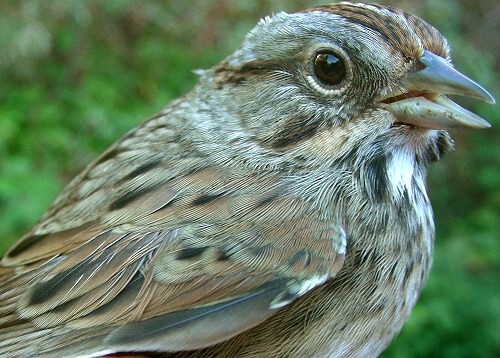
A particularly gray-faced individual, even including a grayish eye ring.
Photo by Marie-Anne Hudson,
McGill Bird Observatory (QC), September 2007
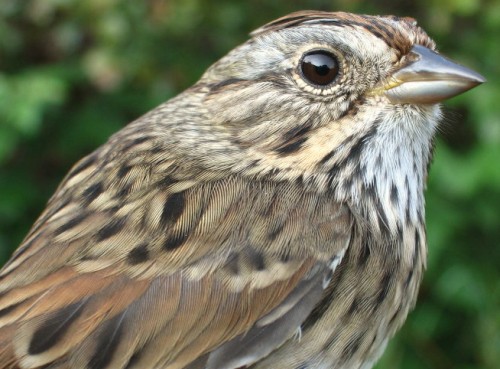
A more typical AHY Lincoln's Sparrow, with a beige eye ring, but still a largely gray face.
Photo by Seabrooke Leckie,
McGill Bird Observatory (QC), September 2006
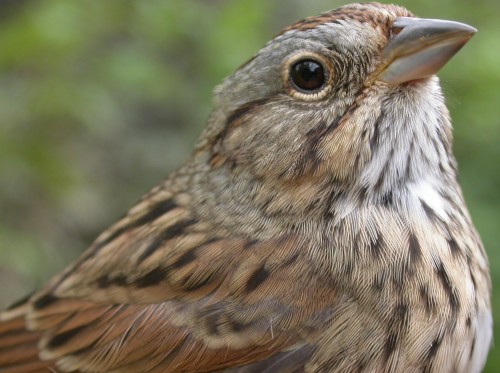
Photo by Marcel Gahbauer,
McGill Bird Observatory (QC), September 2005
AHY Lincoln's Sparrows have broad and truncate primary coverts, usually
with some distinct pale brown edging, and little contrast across the wing.
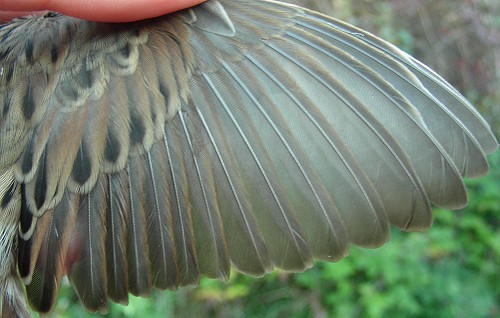
A typical AHY wing, with distinct edging to the broad primary coverts.
Photo by Marie-Anne Hudson,
McGill Bird Observatory (QC), September 2007
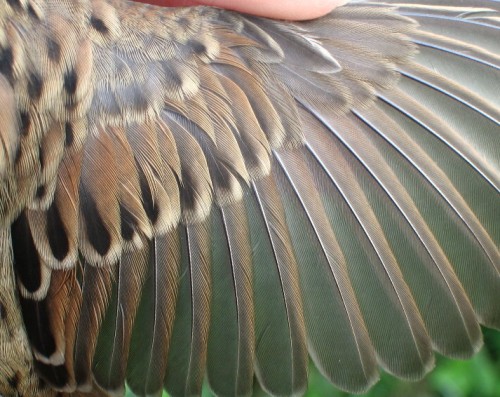
Another example, with the entire wing appearing dark and fresh, and a distinct border to
all of the primary coverts.
Photo by Seabrooke Leckie, McGill Bird Observatory (QC), September 2006
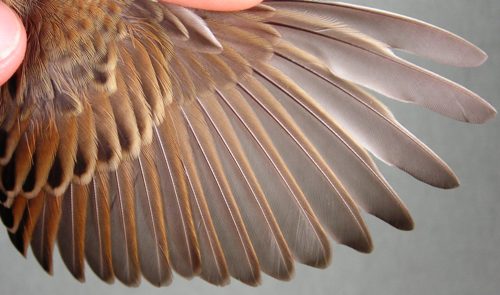
A west coast example, with the border on the primary coverts somewhat less distinct, but
they are still broad and rounded, and the wing has a largely uniform quality.
Photo by Peter Pyle, Big Sur Ornithology Lab (CA), September 2007
Rectrices of AHY birds are fairly broad, but there can be a fair amount of
variation, and the tail should not be used as a primary determinant of age.

A typical AHY tail, with broad and rather blunt-tipped outer rectrices.
Photo by Marie-Anne Hudson,
McGill Bird Observatory (QC), September 2007
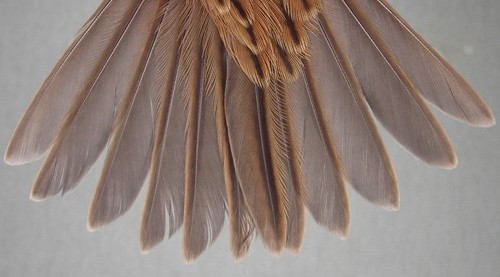
Another typical example, showing broad rectrices across most of the tail.
Photo by Peter Pyle, Big Sur Ornithology Lab (CA), September 2007
RETURN TO AGE/SEX
OVERVIEW
|
JUL - DEC: hatch-year
unknown |
Most body plumage provides no useful information about age, but the face of HY Lincoln's Sparrows generally has a golden-beige wash that is subtly distinct from the more grayish face of adults. Sex cannot be determined for HY birds.
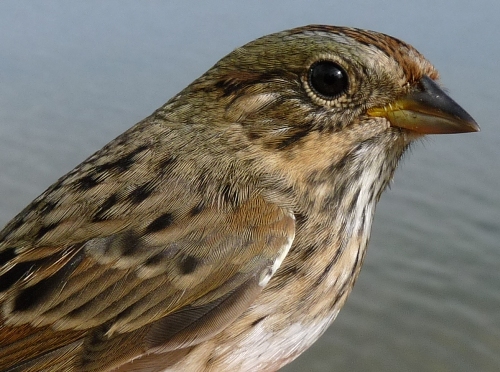
A western Lincoln's Sparrow, with a bit of gray in the supercilium, but overall a brownish
tinge to the face.
Photo by Marcel Gahbauer, Cypress Hills Provincial Park (AB), August 2010
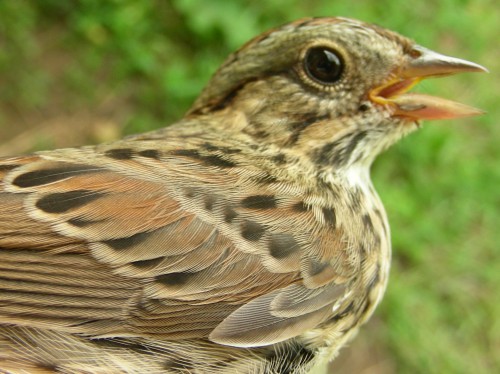
An eastern Lincoln's Sparrow, with a golden tone to much of the face.
Photo by Marie-Anne Hudson,
McGill Bird Observatory (QC), September 2007
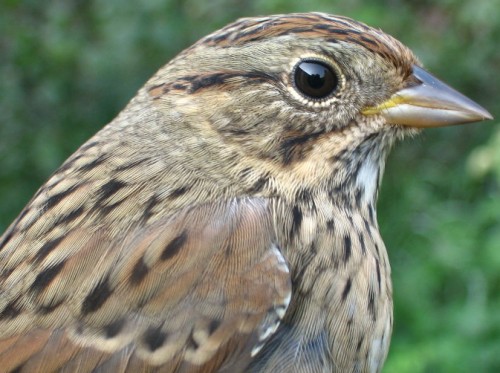
A relatively gray-faced individual, illustrating the need for caution in relying upon this trait.
Photo by Seabrooke Leckie, McGill Bird Observatory (QC), September 2006
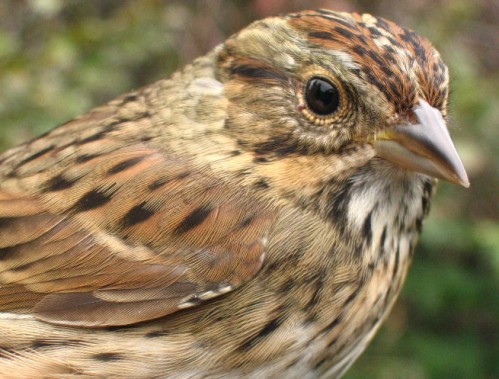
A more distinctly golden-faced HY individual.
Photo by Seabrooke Leckie,
McGill Bird Observatory (QC), September 2006
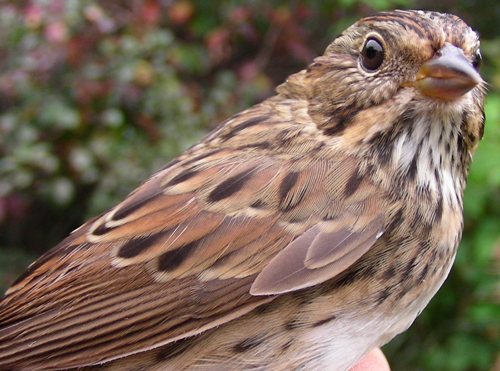
Another example with more beige/brown in the face than gray.
Photo by Marcel Gahbauer,
McGill Bird Observatory (QC), September 2008
As in many other species, primary coverts on HY Lincoln's Sparrows average somewhat narrower and more tapered than on AHY individuals, but the difference can be particularly subtle with this species. There also tends to be less brown edging on the primary coverts, and there may be a contast between the formative greater coverts and the retained juvenile feathers comprising the rest of the wing, but this can also be difficult to detect, especially early in fall. In many cases, age should be determined in conjunction with the tail and or skull ossification.
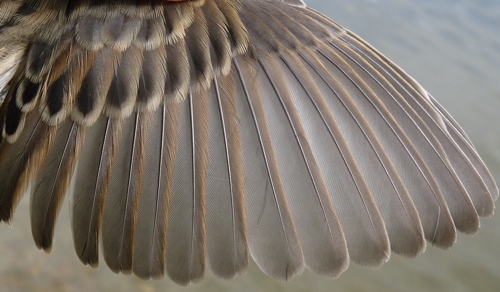
A typical HY wing, showing primary coverts with minimal pale edging, and a slight contrast
between the fresher greater coverts and the remainder of the wing.
Photo by Marcel Gahbauer, Cypress Hills Provincial Park (AB), August 2010
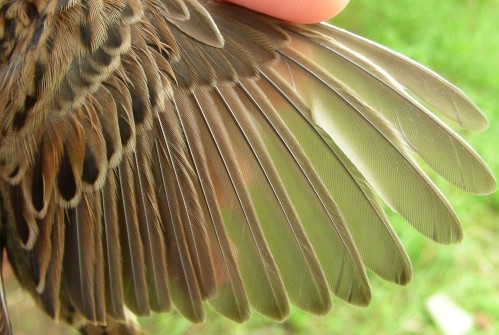
Another example showing that primary coverts may be relatively broad even on HY
individuals, but have minimal edging; in this case the rectrices were the deciding factor.
Photo by Marie-Anne Hudson,
McGill Bird Observatory (QC), September 2007
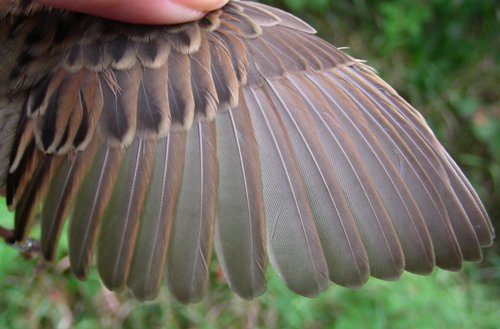
Another example in which the primary coverts provide no distinct clues to age, but where
there is a contrast between the greater coverts and remainder of the wing.
Photo by Marcel Gahbauer,
McGill Bird Observatory (QC), September 2008
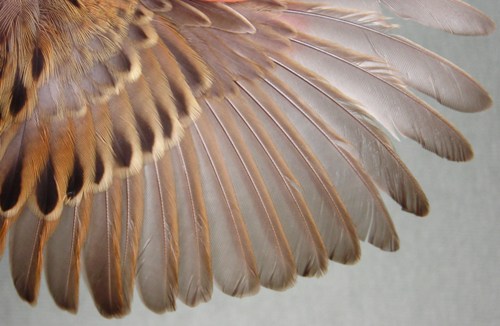
In this example the shape of the primary coverts is somewhat more typical (i.e. narrow and
pointed), but the contrast between the greater coverts and rest of the wing is more subtle.
Photo by Peter Pyle, Big Sur Ornithology Lab (CA), September 2007
HY tails
are generally quite narrow and pointed, although on occasion they may appear closer to the shape expected for AHY individuals (perhaps reflecting earlier replacement of the tail).
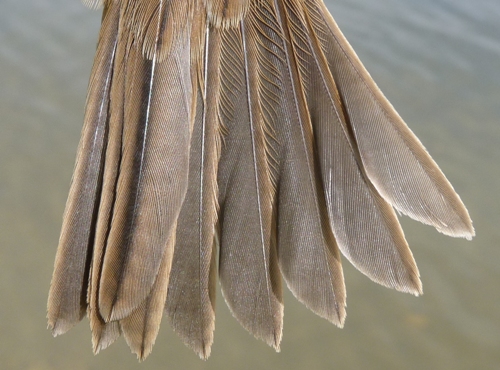
A typical HY tail, with narrow and pointed outer rectrices.
Photo by Marcel Gahbauer, Cypress Hills Provincial Park (AB), August 2010
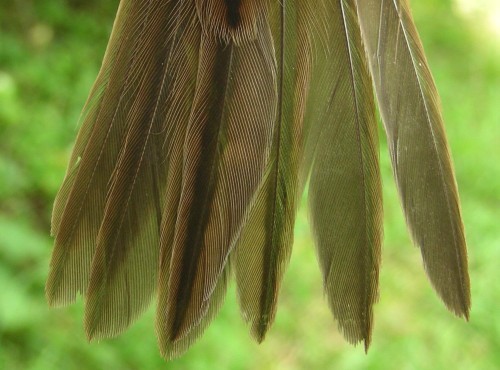
Another typical example, corresponding to the indistinct wing in the previous section.
Photo by Marie-Anne Hudson,
McGill Bird Observatory (QC), September 2007
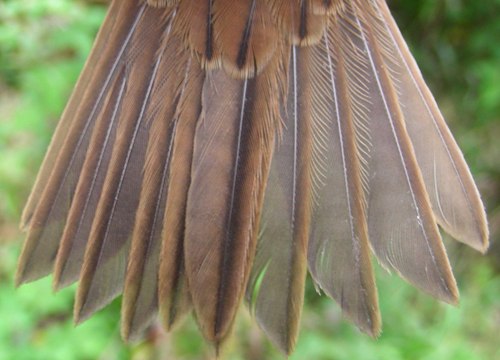
Photo by Marcel Gahbauer,
McGill Bird Observatory (QC), September 2008
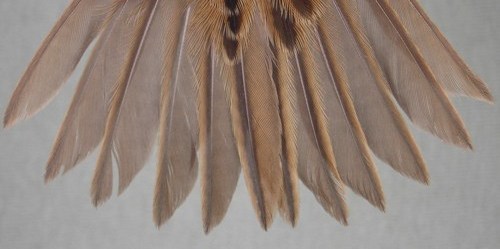
An example with particularly pointed outer rectrices.
Photo by Peter Pyle, Big Sur Ornithology Lab (CA), September 2007
RETURN TO AGE/SEX
OVERVIEW
JUL - AUG: juvenile
unknown |
Juvenile plumage is usually seen only on the breeding grounds, and can be very similar to juvenile Swamp Sparrows. Note the slightly longer bill and somewhat lesser contrast on the greater coverts of Lincoln's Sparrows.
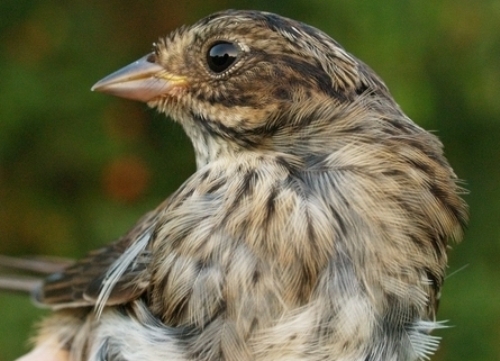
A juvenile Lincoln's Sparrow, with a facial pattern very similar to that of juvenile Swamp
Sparrows, but with a slightly shorter bill.
Photo by Simon Duval,
McGill Bird Observatory (QC), August 2010
The juvenile wing is quite similar to that of HY individuals, with the exception that the greater coverts have not yet been replaced, and are at this stage more similar in appearance to the rest of the wing. Note that the juvenile greater coverts are dark with beige edging at the tips, but the contrast is not as strong as the nearly black and beige-yellow typical of juvenile Swamp Sparrows. Also, Swamp Sparrows tend to have somewhat more rusty edging to the primaries and secondaries as juveniles.
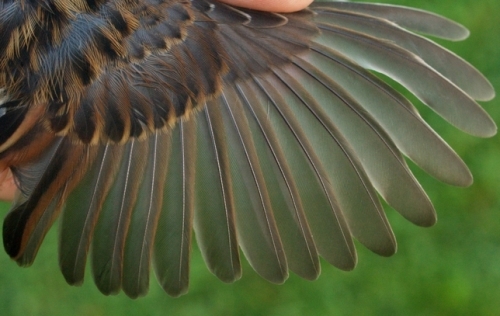
Photo by Simon Duval,
McGill Bird Observatory (QC), August 2010
Juvenile rectrices are relatively narrow and tapered, consistent with the appearance of HY individuals, since the rectrices are not part of the preformative molt.
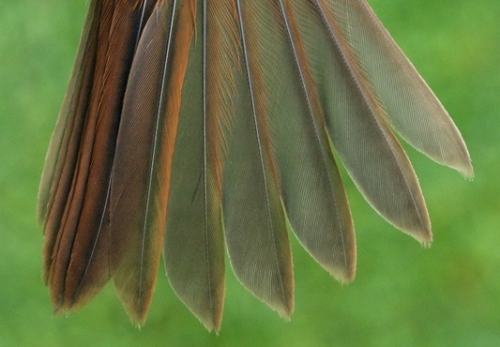
Photo by Simon Duval,
McGill Bird Observatory (QC), August 2010
RETURN TO AGE/SEX
OVERVIEW

















































